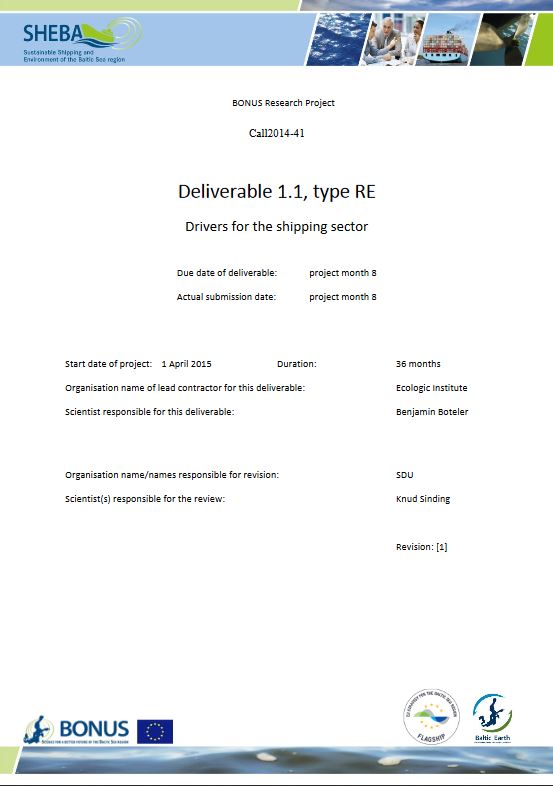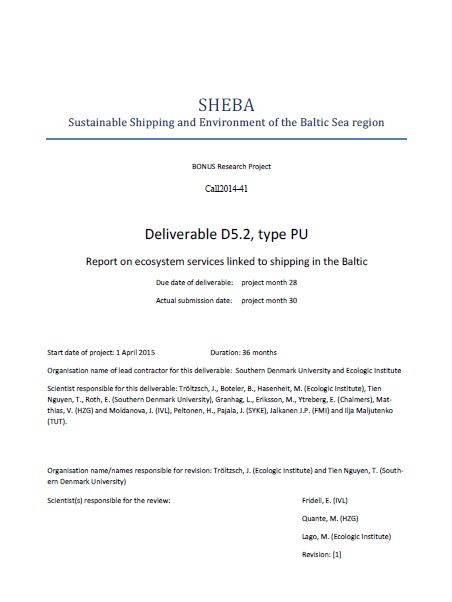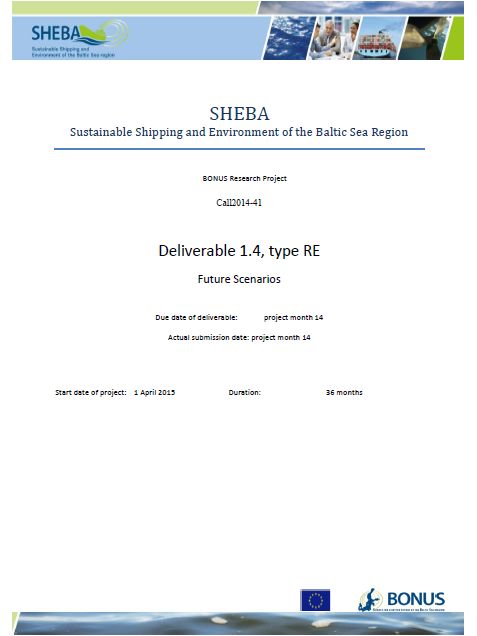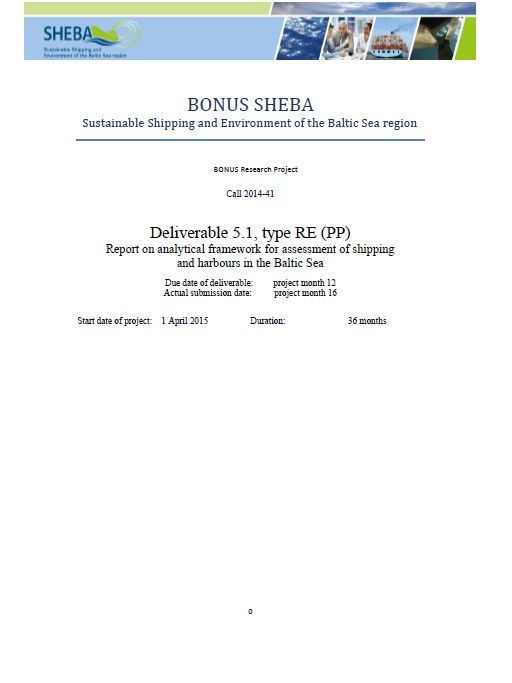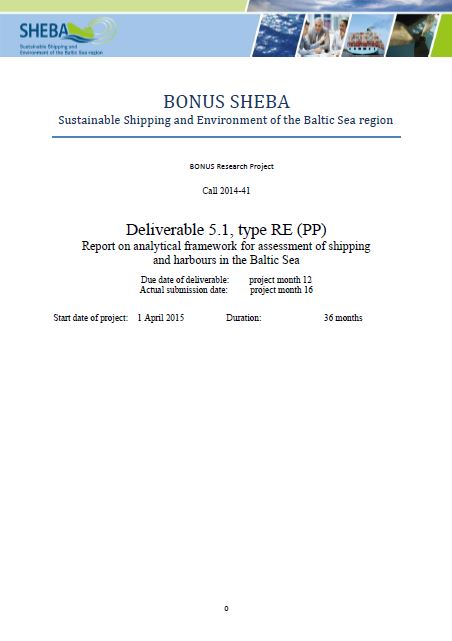Policy Evaluation and Tradeoffs to Reduce Environmental Pressures of Shipping in the Baltic Sea
Deliverable 5.3 – Sustainable Shipping and Environment of the Baltic Sea Region (SHEBA)
- Publication
- Citation
Tröltzsch, Jenny et. al. 2015: Report on Policy Evaluation and Tradeoffs to Reduce Environmental Pressures of Shipping in the Baltic Sea. Deliverable 5.3. BONUS Research project Sustainable Shipping and Environment of the Baltic Sea Region (SHEBA).
The objective of this report is to provide a socio-economic assessment for the evaluation of policy options that have the potential to reduce environmental pressures from shipping in the Baltic Sea and move towards policy objectives especially on EU and global level. The report describes the assessment of 20 selected policy options that focus on different environmental pressures from shipping.
The evaluation is based on a developed multidimensional assessment framework which includes eight assessment criteria (political implementability, acceptance & feasibility, scientific knowledge & uncertainty, technological & innovation potential, environmental and health outcomes, efficiency, distributional effects, synergies & tradeoffs). As part of the policy options' assessment, their potential effect on different environmental pressures and on human health and ecosystem services such as commercial fishing or recreation and tourism is analysed. The result is a semi-quantitative and participatory multi-criteria assessment.
- Language
-
English
- Authorship
-
Roth, E. (SDU)Matthias, V., Quante, M. (HZG)Fridell, E., Moldanova, J. (IVL)Jalkanen, J.- P. (FMI)Hassellöv, I.-M., Ytreberg, E., Granhag, L., Eriksson, M. (Chalmers)
- Funding
-
BONUS Secretariat (EEIG) (BONUS Secretariat), International - Year
- Dimension
- 210 pp.
- Project
- Project ID
- Table of contents
-
Click to show full table of contents
1 INTRODUCTION
2 APPROACH
2.1 Stakeholder consultation
2.1.1 First SHEBA Stakeholder meeting in Hamburg
2.1.2 Second SHEBA Stakeholder meeting in Tallinn
2.1.3 Web-survey for assessment of policy options
2.2 Identifying and selection of policy options
2.3 Developing a multi-dimensional assessment framework
2.4 Excursus: Methodology for health impacts assessment and valuation
2.5 Excursus: Methodology for estimation of effects of acidification and eutrophication on ecosystems
3 ASSESSMENT OF POTENTIAL POLICY OPTIONS
3.1 Stakeholder consultation via web-survey
3.2 Summarized assessment results per option
3.2.1 Policy option #1 Sea grass protection: Restrictions on number of boats mooring in certain areas and better enforcement
3.2.2 Policy option #2 Speed regulation: Zoning and maximal speed (Baltic-wide)
3.2.3 Policy option #3 Excluding the noisiest ships / limits on average noise level
3.2.4 Policy option #4 Promoting biocide-free anti-fouling paint and alternatives
3.2.5 Policy option #5 Reduced limits for biocidal release rate for anti-fouling paints
3.2.6 Policy option #6 Guidance on integration of antifouling paints in river basin management plans (RBMPs) and national marine strategies
3.2.7 Policy option #7 Stricter regulation on scrubber water
3.2.8 Policy option #8 Promoting optimized fossil fuel driven engine and ship design, e.g. stricter energy efficiency standard (EEDI)
3.2.9 Policy option #9 Promoting use of low emission fossil fuels, e.g. LNG
3.2.10 Policy option #10 Promoting use of renewable fuels and energy sources, e.g. biofuels, wind
3.2.11 Policy option #11 Limits on methane slip from LNG engines (due to incomplete combustion)
3.2.12 Policy option #12 Promoting use of electric power for running the engine (battery–driven)
3.2.13 Policy option #13 Promoting shore power in ports
3.2.14 Policy option #14 Green port fees linked to ship emissions/pollutants
3.2.15 Policy option #15 Introduction of national fairway dues (charges) which are linked to ship emissions/pollutants
3.2.16 Policy option #16 Initiatives to simplify procedures in ports, e.g. use of communication tools to adjust speed to arrive in ports
3.2.17 Policy option #17 Promote vessel scrapping to reduce environmental impacts of fleets
3.2.18 Policy option #18 Establish PM (including black carbon) emission standards for ships
3.2.19 Policy option #19 Implementation of a CO2-tax for shipping
3.2.20 Policy option #20 Establishing of an emission trading scheme for greenhouse gases from shipping
3.3 Summary and ranking of options
4 SUMMARY AND CONCLUSIONS
5 LITERATURE
6 PART II: IN-DEPTH ASSESSMENT OF POLICY OPTIONS
6.1 Template for options' assessment
6.2 In-depth assessment results for the different policy options
6.2.1 #1 Sea grass protection: Restrictions on number of boats mooring in certain areas and better enforcement
6.2.2 #2 Speed regulation: Zoning and maximal speed (Baltic-wide)
6.2.3 #3 Excluding the noisiest ships / limits on average noise level
6.2.4 #4 Promoting biocide-free anti-fouling paint and alternatives (research funding, financial support for pilots)
6.2.5 #5 Reduced limits for biocidal release rate for anti-fouling paints
6.2.6 #6 Guidance on integration of antifouling paints in river basin management plans (RBMPs) and national marine strategies
6.2.7 #7 Stricter regulation on scrubber water
6.2.8 #8 Promoting optimized fossil fuel driven engine and ship design, e.g. stricter energy efficiency standard (EEDI)
6.2.9 #9 Promoting use of low emission fossil fuels, e.g. LNG
6.2.10 #10 Promoting use of renewable fuels and energy sources, e.g. biofuels, wind
6.2.11 #11 Limits on methane slip from LNG engines (due to incomplete combustion)
6.2.12 #12 Promoting use of electric power for running the engine (battery –driven)
6.2.13 #13 Promoting shore power in ports
6.2.14 #14 Green port fees linked to ship emissions/pollutants
6.2.15 #15 Introduction of national fairway dues (charges) which are linked to ship emissions/pollutants
6.2.16 #16 Initiatives to simplify procedures in ports, e.g. use of communication tools to adjust speed to arrive in ports
6.2.17 #17 Promote vessel scrapping to reduce environmental impacts of fleets (financial support)
6.2.18 #18 Establish PM (including black carbon) emission standards for ships
6.2.19 #19 Implementation of a CO2-tax for shipping
6.2.20 #20 Establishing of an emission trading scheme for greenhouse gases from shipping - Keywords
-
GHG, air pollutant emissions (SOX, NOX, PM), water emissions (including invasive species, water pollutants, heavy metals, underwater noise, physical impactsBaltic Sea
Fridell, Erik et. al. 2015: Future Scenarios. Deliverable 1.4. BONUS Research project Sustainable Shipping and Environment of the Baltic Sea Region (SHEBA).
Hasenheit, Marius and Jenny Tröltzsch (2018): Policies for Sustainable Shipping in the Baltic Sea - a ranking. SHEBA Policy Brief. BONUS Research project SHEBA.
Quante, Markus; Insa Puchert; Katrina Abhold et.al. 2016: Brief of Stakeholder Meeting: Considerations for the Baltic Sea Shipping Sector.
